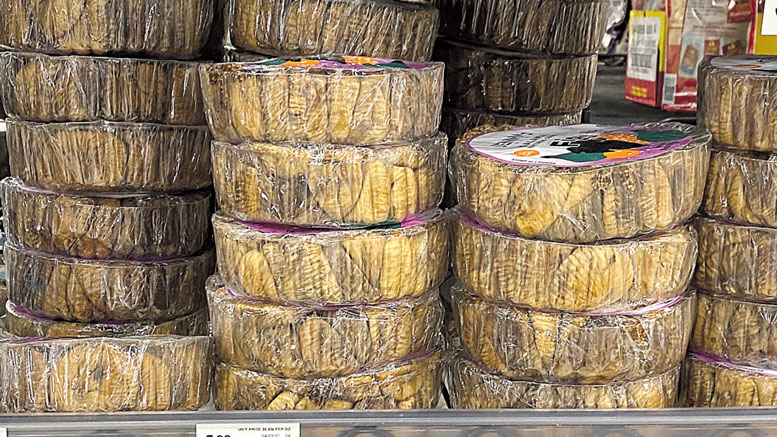FIG-URE IT OUT! HOW TO SELL MORE DRIED FIGS
September 6, 2023 | 5 min to read
Dried figs, a staple since at least 5,000 B.C. and now exclusively from California, are experiencing a surge in consumer demand, particularly after the pandemic. According to Karla Stockli from the California Fig Advisory Board, consumption is at an all-time high. Popular varieties include Mission and golden figs, marketed both conventionally and organically. Innovative products such as Fignuts reflect growing market dynamics, while effective merchandising and nutritional promotion drive sales.

PRODUCE BUSINESS/SUSAN CROWELL PHOTO
Grab-and-go, impulse buy or planned purchase: Dried figs are gaining in popularity.
Originally printed in the August 2023 issue of Produce Business.
Mankind has munched on dried figs since at least 5,000 B.C., according to the discovery of fig trees in archaeological sites near its native Turkey.
Today, all dried figs grown commercially in the U.S. come from California.
The good news? “Consumer demand for figs has been on the rise for several years,” says Karla Stockli, chief executive of the California Fig Advisory Board (CFAB), in Madera, CA.
“Dried fruit, in general, saw an increase during the pandemic, so dried fig consumption continued to increase,” says Stockli. “Today, consumer demand for figs is at an all-time high.”
Fig sales span nationwide, from east to west.

“All dried fruits and nuts sell well in Manhattan, where grab-and-go snacking is big,” says Marc Goldman, produce director at Morton Williams Supermarkets, a 16-store chain based in Bronx, NY. “Dried golden figs are part of the mix in these sets.”
At New Leaf Community Markets, a six-store chain based in Santa Cruz, CA, Maroka Kawamura, senior category manager of produce, added dried figs to the store’s assortments in produce “due to consumer interest in the product.”
There is definitely room to grow sales since the per capita consumption of dried figs is 0.1 pounds per person annually, based on the U.S. Department of Agriculture’s Economic Research Service.
ANNUAL AVAILABILITY
There are two primary dried fig varieties grown in California — Mission figs and golden figs, explains Stockli. “California Dried Mission Figs are signature to California. California Dried Golden Figs are the generic term for a number of ‘white’ varieties, including Kadota, Sierra and Tena, among others. Some packages will have the variety noted, but more often you’ll see ‘California Golden Figs,’ which means you’ll get a nutty and buttery fig flavor. Both varieties are popular with consumers and available year-round.”
Western Mixers Produce & Nuts Inc., based in Ontario, CA, sells black Mission figs and Sierra figs, says the company’s Kristin Bolstad, including bulk 30-pound, 5-pound, 24/9-ounce cases, and also repacks for retail.
At San Joaquin Figs Inc., in Fresno, CA, the top-selling dried figs are in tubs and crown packages. “We have traditionally excelled in bulk and have focused more in recent years on our own retail line,” says Marlene Piceno, marketing and sales coordinator.

The California fig industry produces both conventional and organic.
“The demand for organic is on par with other fruits and vegetables. There is definitely a market for both,” says Stockli.
“Figs are very limited in dried organic assortment, so we have one vendor/label we rely on, and they are a slow, but steady, mover,” tells New Leaf Community Markets’ Kawamura.
Trucco, a larger global importer and national distributor of fresh produce based in New York City’s Hunts Point Market, in the Bronx, NY, buys and sells dried Mission and golden figs from California year-round. It also imports dried figs year-round from Turkey, according to John Magna, category manager.
“Starting in late September or early October to December, we’ll bring in Greek figs for the holidays. They usually sell fast.”
The U.S. is a leading market for Turkish dried figs, with $35 million worth of the golden variety fruit exported to the USA during the 2021-2022 season, according to data from the Aegean Dried Fruits and Products Exporters’ Association, in Izmir, Turkey.
New value-added fig products are natural to sell in the produce department, too.
“We are excited about one of our new products, Fignuts,” says San Joaquin Figs’ Piceno. “Fignuts are a fig and nut-based bar made with fruits and nuts we grow, or the ingredients are supplied by folks we have a close relationship with. We currently offer three flavors: Chocolate Brownie, Cherry Pie and BerrySplosion.”
SELL MORE
Typically, whole dried figs are displayed in the produce department if other dried fruit products are also merchandised there, according to the CFAB’s Stockli.
“We think placing the figs on the ends of the produce displays as end caps is always a good option and making sure they are placed up high, not on the lower shelves. If possible, it is great to mix them in with the fruit and vegetable displays,” recommends Western Mixers Produce & Nuts’ Bolstad.
Fig’s nutrient content is a strong point of promotion. Three dried figs provide nearly one-fifth of a day’s suggested intake of dietary fiber in only 120 calories. Plus, a half cup of dried figs provides calcium equal to a half cup of milk, and three to five dried figs serve up potassium equivalent to half a banana, two nutrients essential to good health.
The CFAB has worked with many retailers over the years, Stockli adds, and most recently, partnered with a handful of retail dietitians to develop recipes, write newsletter and social media content, and sample at their respective stores.
“We saw a 300% sales lift in one chain when California dried figs were sampled in a simple three-ingredient recipe, like figs, chocolate and sea salt, or figs, blue cheese, and almonds,” says Stockli. “We would love to partner with retailers and have many recipes, tips, and nutrition facts to share with consumers. We even have our own California Figs Cookbook available as a giveaway item for consumers.”
10 of 12 article in Produce Business September 2023

